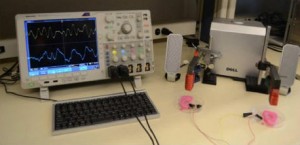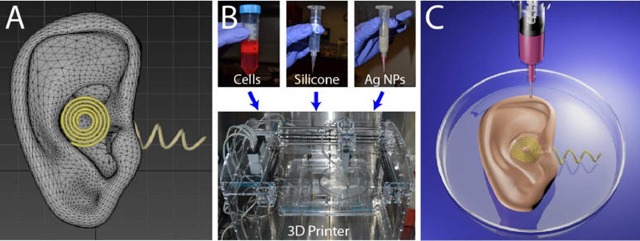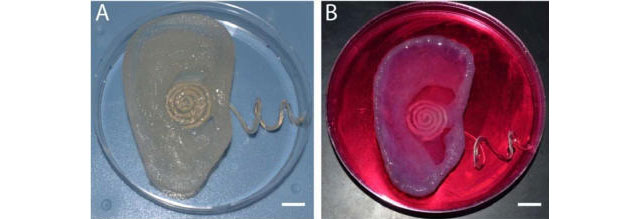It seems that the Singularity may be nearer than previously thought. While some scientists are stuck on printing ordinary human organs, scientists at Princeton have skipped years ahead to cybernetics (commonly called bionics), which is the manufacture of electronically modified biological material. Using a similar hydrogel to that which is used in other forms of printed biological tissue, Princeton scientists have 3D printed a human ear infused with electronic components, yielding a fabricated ear that can pick up radio waves.
The ear was chosen for its structural complexity, as ears are difficult to manufacture with processes other than 3D printing, and also for its biological simplicity. Since ears are only made of cartilage and lack complex vasculature, the experiment might have a higher chance of success. And, using a simple NextFab FFF printer, they were able to accomplish the task, performing a multimaterial print. A chondrocyte seeded alginate hydrogel was used to lay out the shape of the ear so that, when dunked into a vat of cartilage inducing culture, the cartilage could form around the hydrogel and absorb it. Simultaneously, a conductive material, a nanoparticle called AgNP, was printed into the ear structure, to act as an antennae, and connected to a “cochlear like electrode”.

It’s worth reading the actual study, not just to learn about the experiment from people who actually know what they’re saying, but to read such quaintly sci-fi sentences as “since electronic circuitry is at the core of sensory and information processing devices, in vitro culturing of the printed hybrid architecture enables the growth of ‘cyborg organs’ exhibiting enhanced functionalities over human biology.”
The applications for such technology are as endless as the limits of the imagination. Aside from giving you every superhero power that you pictured having as a kid, such a combination of electronic and biological print materials could potentially help the differently abled, giving the blind the ability to see and the deaf the ability to hear.
Or, perhaps, Steve Austin (aka Lee Majors) could be resurrected in the 21st century?





